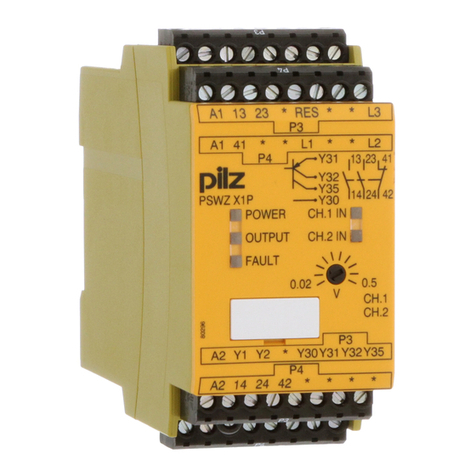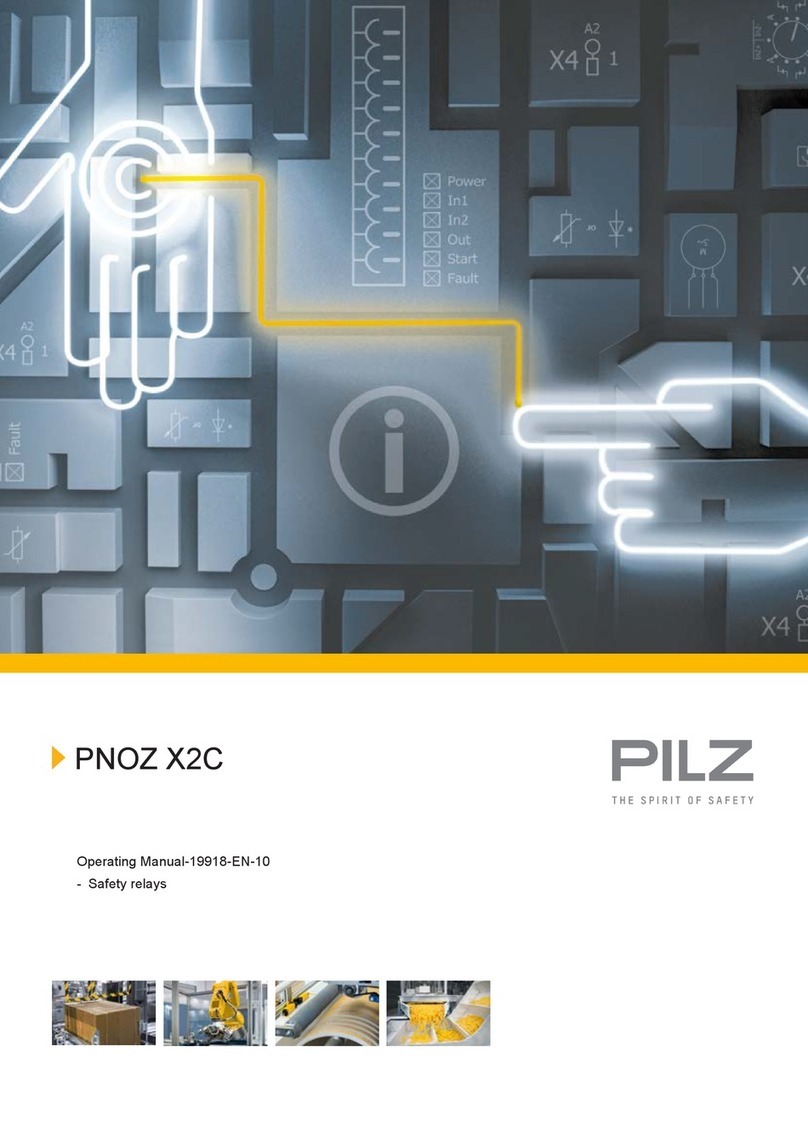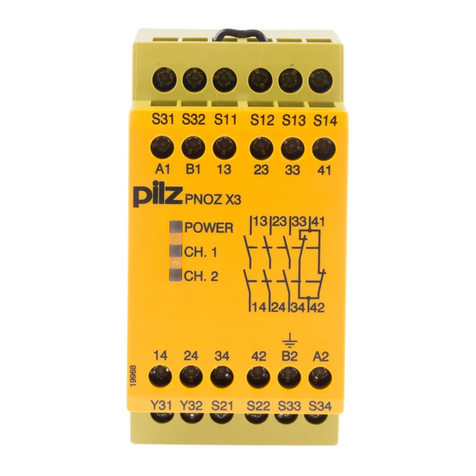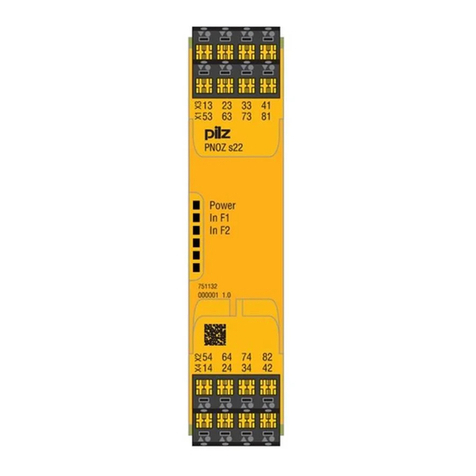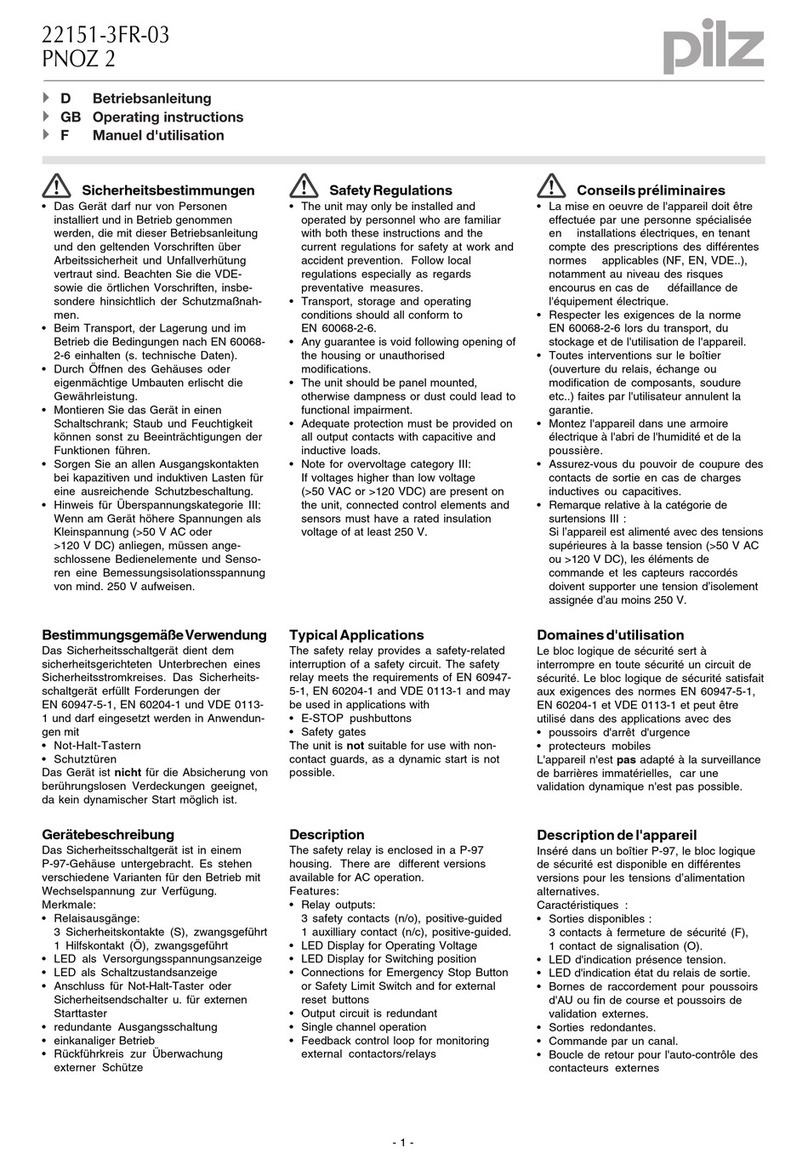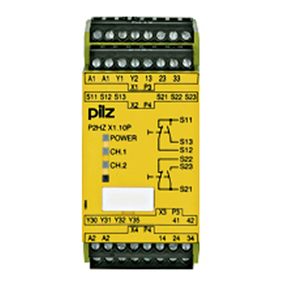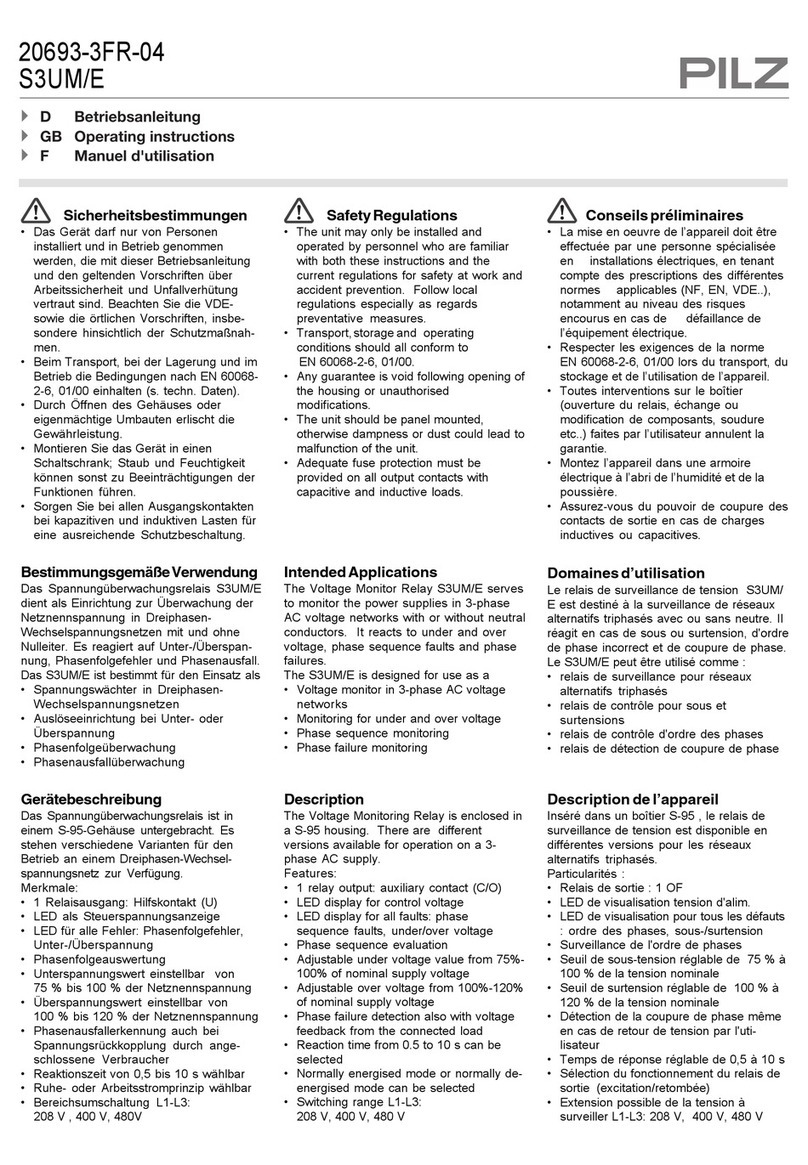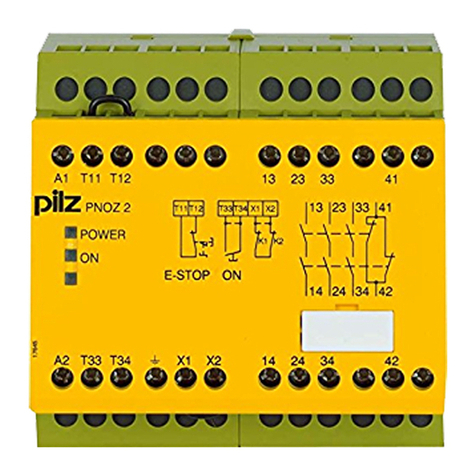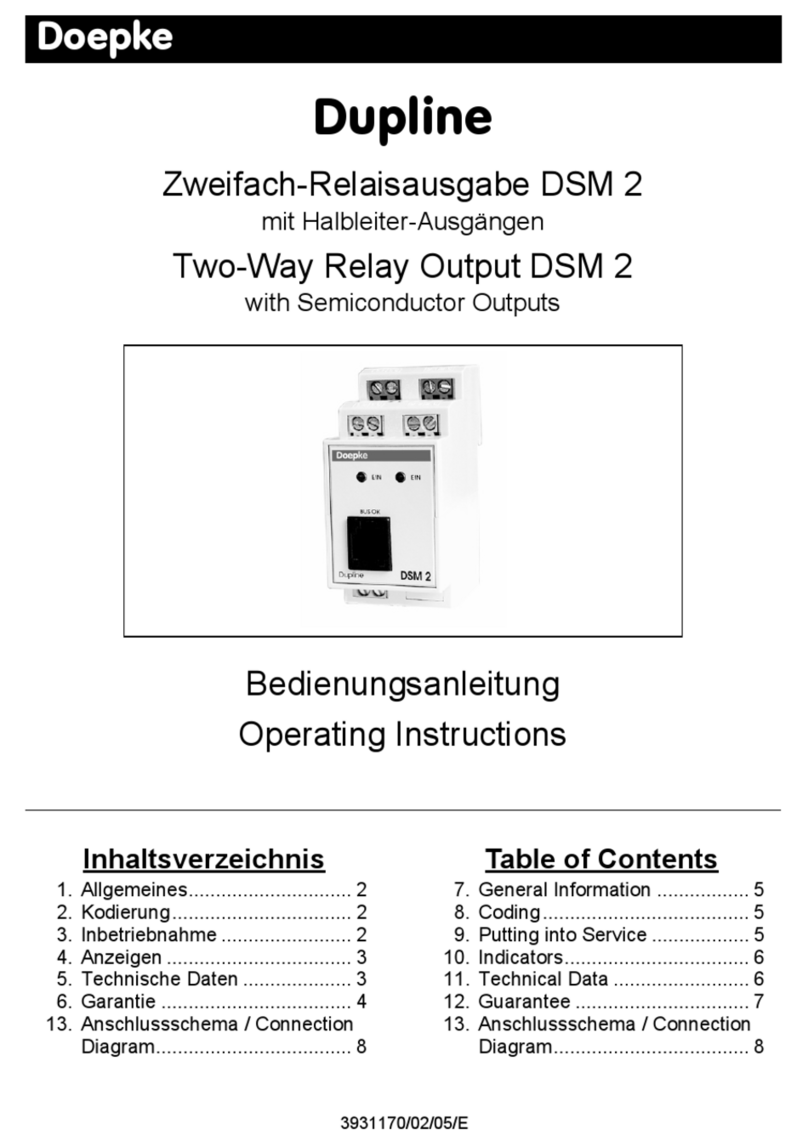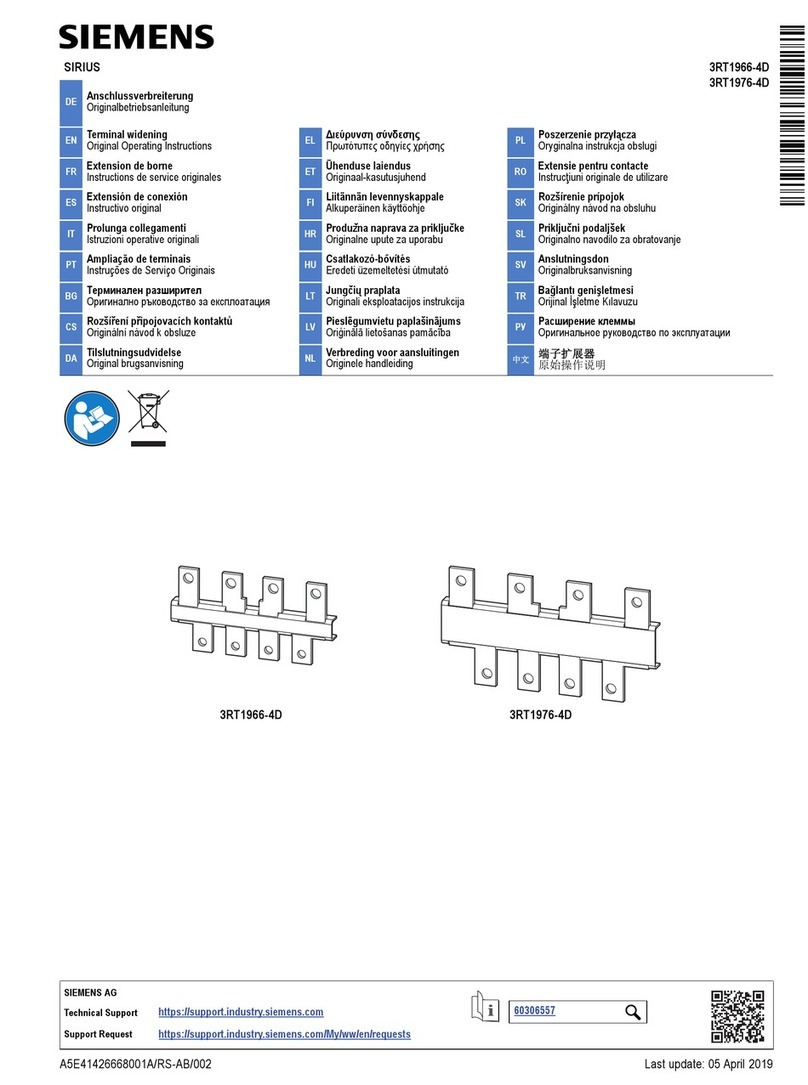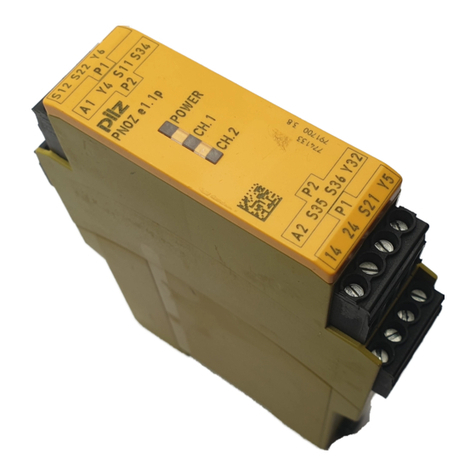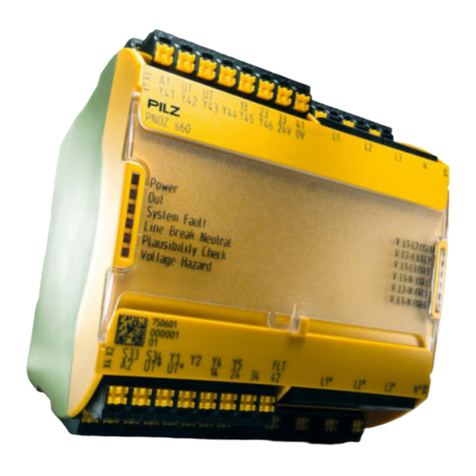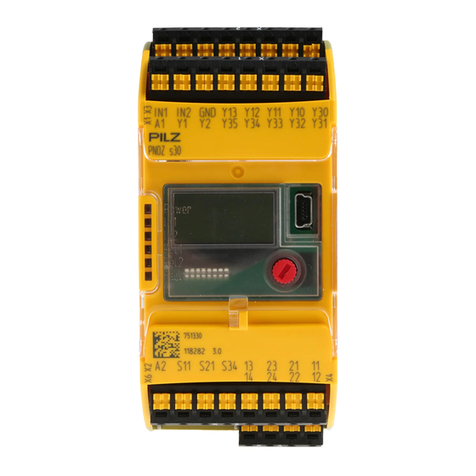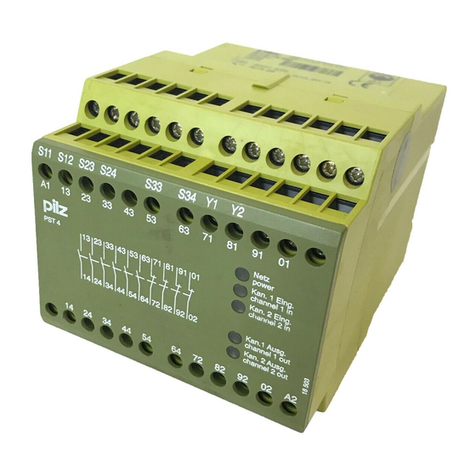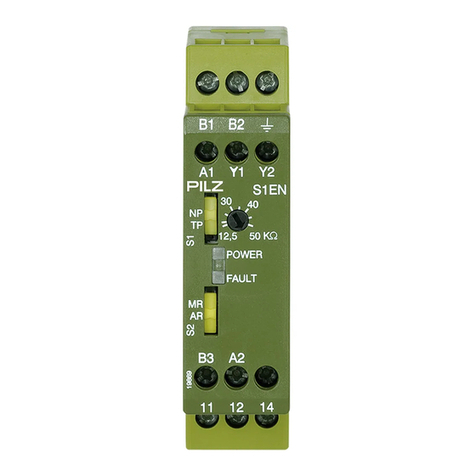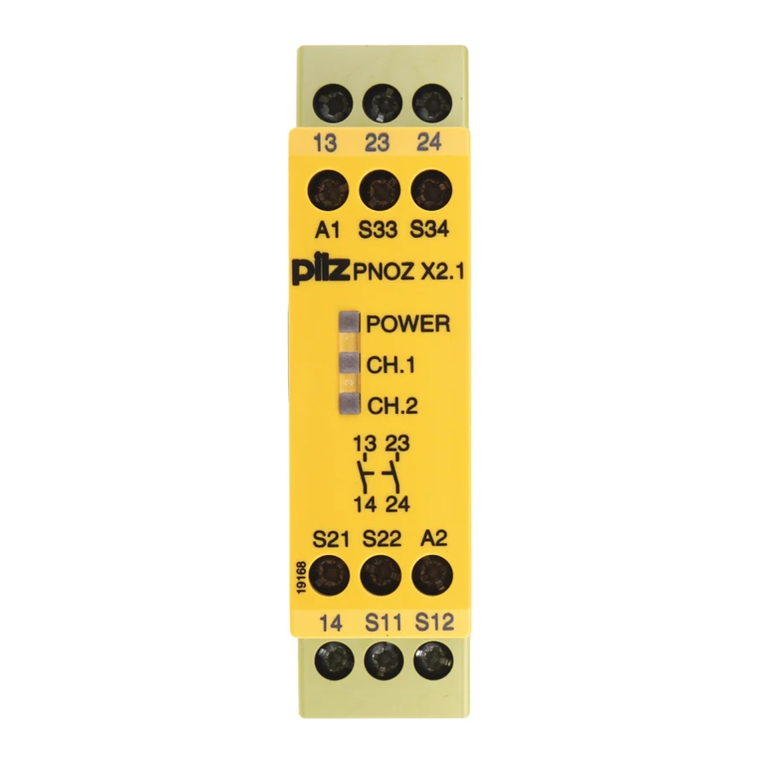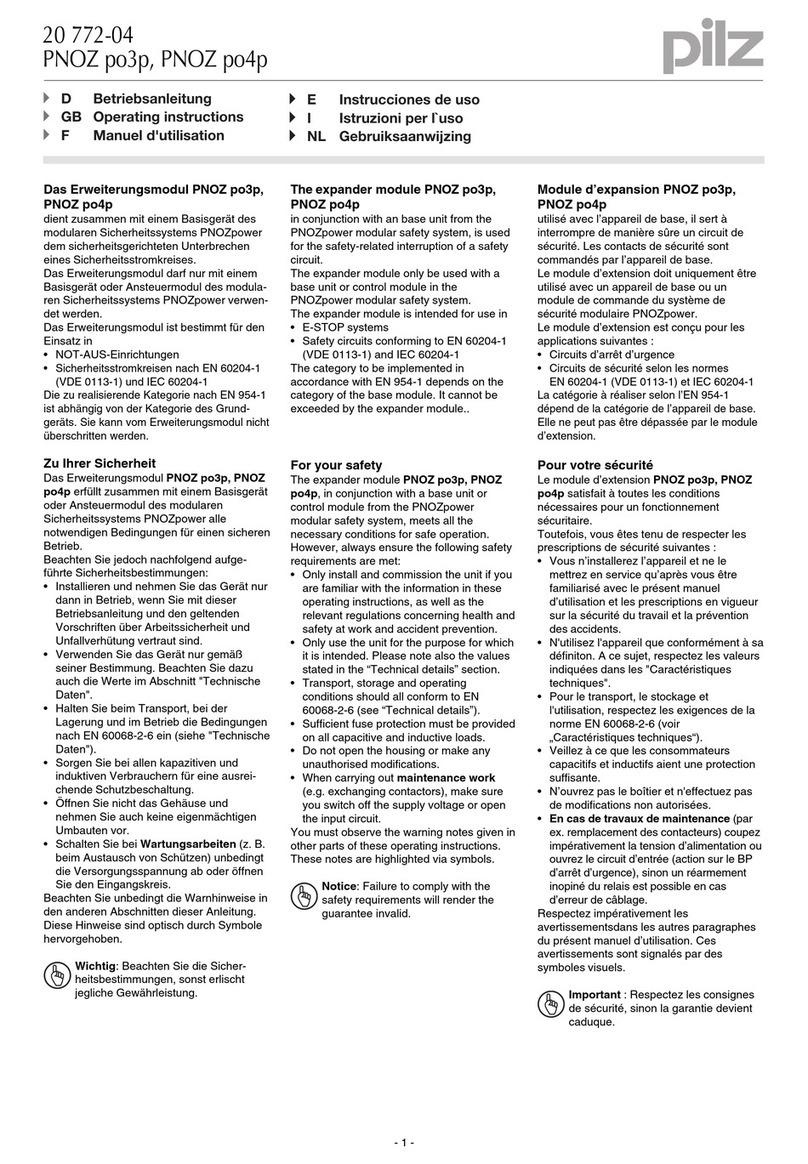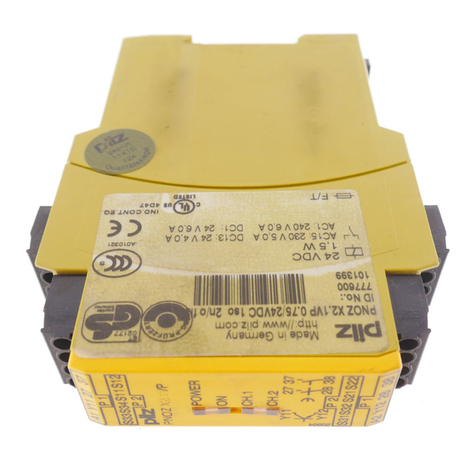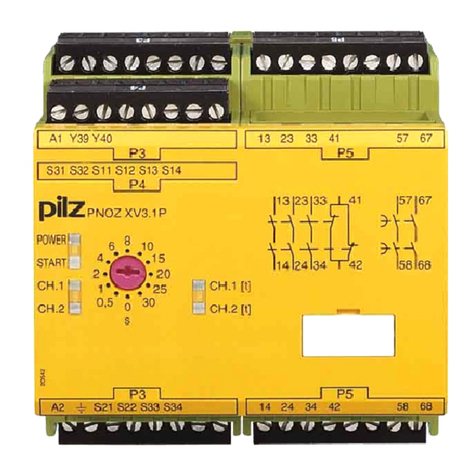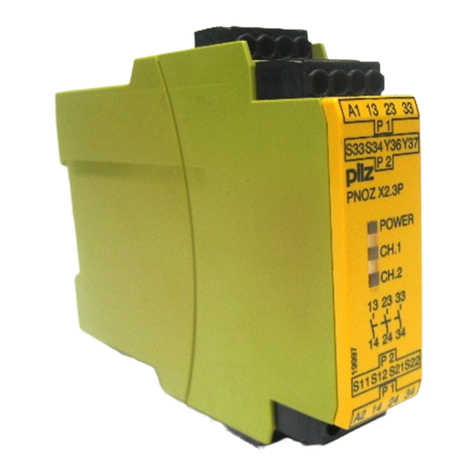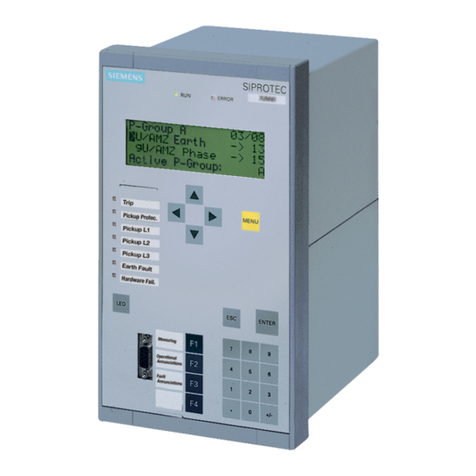
- 3 -
Betriebsarten:
• Einkanaliger Betrieb:
Eingangsbeschaltung nach VDE 0113 und
EN 60204, keine Redundanz im Eingangs-
kreis, Erdschlüsse im Tasterkreis werden
erkannt.
• Zweikanaliger Betrieb: Redundanter Ein-
gangskreis, Erdschlüsse im Tasterkreis
und Querschlüsse zwischen den Taster-
kontakten werden erkannt.
• Automatischer Start: Gerät ist aktiv, sobald
Eingangskreis geschlossen ist.
• Manueller Start mit Überwachung: Gerät
ist nur aktiv, wenn vor dem Schließen des
Eingangskreises der Startkreis (S33-S34)
geöffnet wird und mind. 300 ms nach dem
Schließen des Eingangskreises der
Startkreis geschlossen wird. Dadurch ist
eine automatische Aktivierung und
Überbrückung des Starttasters
ausgeschlosssen.
• Kontaktvervielfachung und -verstärkung
durch Anschluss von externen Schützen
Montage
Das Sicherheitsschaltgerät muss in einen
Schaltschrank mit einer Schutzart von mind.
IP54 eingebaut werden. Zur Befestigung auf
einer Normschiene dient ein Rastelement auf
der Rückseite des Geräts.
Sichern Sie das Gerät bei Montage auf einer
senkrechten Tragschiene (35 mm) durch ein
Halteelement wie z. B. Endhalter oder
Endwinkel.
Inbetriebnahme
Beachten Sie bei der Inbetriebnahme:
• Auslieferungszustand: Brücke zwischen
S11-S12 (Eingangskreis zweikanalig) und
Y39-Y40.
•Vor die Ausgangskontakte eine
Sicherung (s. technische Daten)
schalten, um das Verschweißen der
Kontakte zu verhindern.
• Berechnung der max. Leitungslänge Imax
(Eingangskreis):
R
lmax
R
l
/ km
I
max
=
Rlmax = max. Gesamtleitungswiderstand
(Eingangskreis)
Rl/km = Leitungswiderstand/km
• Da die Funktion Querschlusserkennung
nicht einfehlersicher ist, wird sie von Pilz
während der Endkontrolle geprüft. Eine
Überprüfung nach der Installation des
Geräts ist wie folgt möglich:
1. Gerät betriebsbereit (Ausgangskontakte
geschlossen)
2. Die Testklemmen S22-S32 zur
Querschlussprüfung kurzschließen.
3. Die Sicherung im Gerät muss auslösen
und die Ausgangskontakte öffnen. Lei-
tungslängen in der Größenordnung der
Maximallänge können das Auslösen der
Sicherung um bis zu 2 Minuten verzögern.
4.
Sicherung wieder zurücksetzen: den
Kurzschluss entfernen und die Versor-
gungsspannung für ca. 1 Minute
abschal-
ten.
• Das Netzteil muss den Vorschriften für
Funktionskleinspannungen mit sicherer
elektrischer Trennung (SELV, PELV)
nach VDE 0100, Teil 410 entsprechen.
• Leitungsmaterial aus Kupferdraht mit einer
Temperaturbeständigkeit von 60/75 °C
verwenden.
Operating Modes
• Single-channel operation: Input wiring
according to VDE 0113 and EN 60204, no
redundancy in the input circuit, earth faults
are detected in the emergency stop circuit.
• Two-channel operation: Redundancy in the
input circuit, earth faults in the Emergency
Stop circuit and shorts across the emer-
gency stop push button are also detected.
• Automatic reset: Unit is active as soon as
the input circuit is closed.
• Manual reset with monitoring: The unit is
only active if, the reset circuit (S33-S34) is
opened before closing the safety input
circuit, and then the reset circuit is closed
at least 300 ms after closing the safety
input circuit. This prevents automatic reset
and the reset button bridging.
• Increase in the number of available
contacts by connection of external
contactors/relays.
Installation
The safety relay must be panel mounted
(min. IP54). There is a notch on the rear of
the unit for DIN-Rail attachment.
If the unit is installed on a vertical mounting
rail (35 mm), ensure it is secured using a
fixing bracket such as end bracket.
Operation
Please note for operation:
• Unit delivered with a bridge between S11-
S12 (2-channel input circuit) and Y39-Y40.
•To prevent contact welding, a fuse
should be connected before the output
contacts (see technical details).
• Calculate the max. Cable runs Imax (Input
circuit)
R
lmax
R
l
/ km
I
max
=
Rlmax = Max. Total cable resistance (Input
circuit)
Rl/km = Cable resistance/km
• As the function for detecting shorts across
the inputs is not failsafe, it is tested by Pilz
during the final control check. However, a
test is possible after installing the unit and
it can be carried out as follows:
1. Unit ready for operation (output contacts
closed)
2. Short circuit the test (connection)
terminals S22-S32 for detecting shorts
across the inputs.
3. The unit‘s fuse must be triggered and
the output contacts must open. Cable
lengths in the scale of the maximum length
can delay the fuse triggering for up to 2
minutes.
4. Reset the fuse: remove the short circuit
and switch off the operating voltage for
approx. 1 minute.
• The power supply must comply with the
regulations for extra low voltages with safe
electrical separation (SELV, PELV) in
accordance with VDE 0100, Part 410.
• Use copper wiring that will withstand
60/75 °C
Modes de fonctionnement
• Commande par 1 canal : conforme aux
prescriptions de la EN 60204, pas de
redondance dans le circuit d’entrée, la
mise à la terre du circuit d’entrée est
détectée
• Commande par 2 canaux: circuit d’entrée
redondant, la mise à la terre et les courts-
circuits entre les contacts sont détectés.
• Réarmement automatique : le relais est
activé dès la fermeture des canaux
d’entrée.
• Réarmement manuel auto-contrôlé: le
relais n'est réarmé que si le circuit de
réarmement (S33-S34) est ouvert avant la
fermeture du circuit d'entrée, puis refermé
au min. 300 ms après la fermeture du
circuit d'entrée. De ce fait un réarmement
automatique ou un pontage du poussoir de
validation est impossible.
• Augmentation du nombre de contacts ou
du pouvoir de coupure par l’utilisation de
contacteurs externes.
Montage
Le relais doit être monté en armoire ayant
unndice de protection mini IP54. Sa face
arrière ipermet un montage sur rail DIN.
Immobilisez l'appareil monté sur un rail DIN
vertical (35 mm) à l'aide d'un élément de
maintien comme par ex. un support ou une
équerre terminale.
Mise en oeuvre
Remarques préliminaires :
• Pontages présents à la livraison: S11-S12
(commande par 2 canaux) et Y39-Y40.
•Raccordez un fusible (voir les
caractéristiques techniques) avant les
contacts de sortie afin d’éliminer tout
risque de fusion.
• Calculer les longueurs de câblage max
Imax (Circuits d’entrée):
R
lmax
R
l
/ km
I
max
=
Rlmax = résistivité de câblage totale max.
(Circuits d’entrée)
Rl/km = résistivité de câblage/km
• La fonction de détection de court-circuit est
testé par Pilz lors du contrôle final. Un test
sur site est possible de la façon suivante :
1. Appareil en fonction (contacts de sortie
fermés)
2. Court-circuiter les bornes de
raccordement nécessaires au test S22-S32
3. Le fusible interne du relais doit
déclencher et les contacts de sortie
doivent s‘ouvrir. Le temps de réponse du
fuisible peut aller jusqu‘à 2 min. si les
longueurs de câblage sont proches des
valeurs maximales.
4. Réarmement du fusible : enlever le
court-circuit et couper l‘alimentation du
relais pendant au moins 1 min.
• L'alimentation doit satisfaire aux
prescriptions relatives aux tensions extra
basses avec une isolation électrique de
sécurité (SELV, PELV) selon VDE 0100,
partie 410.
• Utiliser uniquement des fils de cablâge en
cuivre 60/75 °C.
